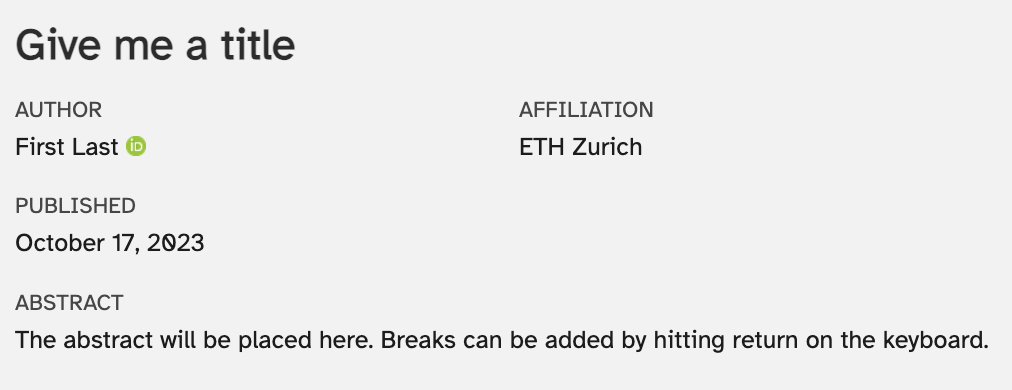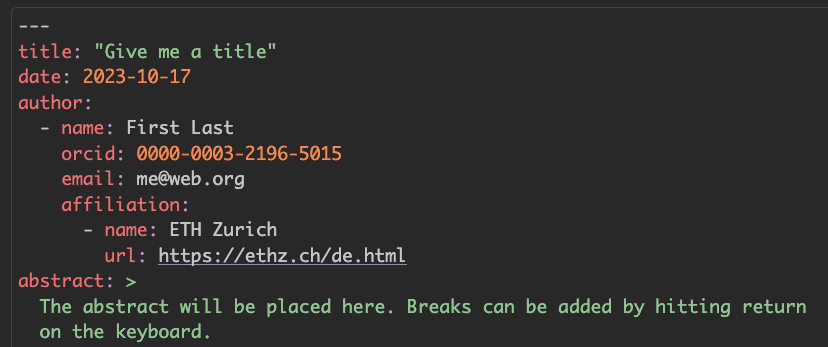10:00
Scholarly writing
OST-HS23: Open Science Tools
authoring and publishing workflows for collaborative scientific writing
October 24, 2023
Reading - pre-work
Good Enough Practices in Scientific Computing

By Wilson et al. (2017)
Your turn
Good Enough Practices in Scientific Computing
- Which recommended practice did you choose?
- In groups of 3: Explain to your neighbours how the recommended practice would improve your research process.
Anatomy of a Quarto scholarly article
Components
Metadata: YAML
Text: Markdown
Code: Executed via
knitrorjupyter
Weave it all together, and you have a beautiful, reproducible journal article!
Four terms
- Citation
- Reference
- Bibliography
- Citation Style Language (CSL)
What’s a Citation?
- Inequality underpins waste management systems, structuring who can or cannot access services (Kalina et al., 2023).
- Many visitors still expect a personal pick-up, despite the availability of taxi services (Tilley & Kalina, 2021).
- In Tilley & Kalina (2021), the authors describe how visitors still expect a personal pick-up, despite the availability of taxi services.
What’s a Citation?
- Inequality underpins waste management systems, structuring who can or cannot access services (Kalina et al., 2023).
- Many visitors still expect a personal pick-up, despite the availability of taxi services (Tilley & Kalina, 2021).
- In Tilley & Kalina (2021), the authors describe how visitors still expect a personal pick-up, despite the availability of taxi services.
Important: The period is after the citation.
What’s a Reference?
- detailed description of the source of information
- author’s name, title, year of publication, publisher, DOI, etc.
Tilley, E., & Kalina, M. (2021). “My flight arrives at 5 am, can you pick me up?”: The gatekeeping burden of the african academic. Journal of African Cultural Studies, 33(4), 538–548. https://doi.org/10.3929/ethz-b-000493677
What’s a Bibliography?
- list of references in a research paper or project
- includes all sources used, whether they were directly quoted or not
- listed alphabetically by the author’s last name in the reference list
References
What’s the Citation Style Language (CSL)?
- It’s what your citation and generated bibliography look like
- APA (American Psychological Association) Style, Chicago Style, IEEE Style, Vancouver Style, etc. (over 10,000 styles in Zotero Style Repository)
What’s the Citation Style Language (CSL)?
author-date: Many visitors still expect a personal pick-up, despite the availability of taxi services (Tilley & Kalina, 2021).
numeric Many visitors still expect a personal pick-up, despite the availability of taxi services [1].
Why use a reference management tool?
Photo by Christian Erfurt on unsplash.com
Why use Zotero?
- free
- open source: developed in public
- transparent about access to your own data
- cross-platform (Windows, Mac, Linux)
- collaboration in groups
- integration with word processors
Photo by Sincerely Media on unsplash.com
Scholarly Articles in Quarto
Quarto supports
a standardized schema for authors and affiliations that can be expressed once int the source document,
the use of Citation Style Language (CSL) to automate the formatting of citations and bibliographies, and
outputting to
pdf,html, anddocxwith custom formatting,
according to the styles required for various journals,
and creating the LaTeX required for submission to multiple journals.
Front matter
Quarto provides a rich set of YAML metadata keys to describe the details required in the front matter of scholarly articles.
- title
- author
- affiliation
- abstract
- keywords
- citation
- licensing
- etc.


Our turn
- Open
scholarly-writing.qmdin RStudio. - Use the visual editor mode
- Follow the instructions in the document
Journal formats
| Journal / Publisher | Name |
|---|---|
| Association of Computing Machinery | acm |
| American Chemical Society | acs |
| American Geophysical Union | agu |
| Biophysical journal | biophysical-journal |
| Elsevier Journals | elsevier |
| American Statistical Association Journals | jasa |
| Journal of Statistical Software | jss |
| Public Library of Science | plos |
Learn more


